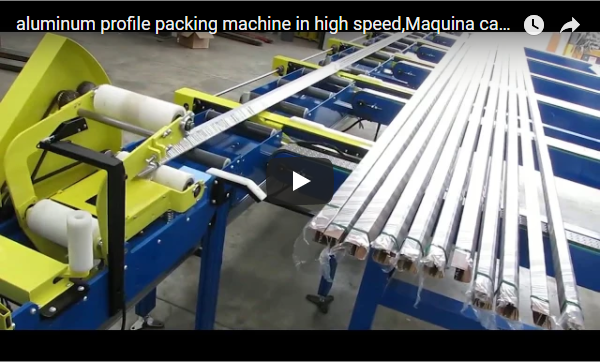Optimizing Aluminum Profile Packaging: A Technical Look at High-Speed Wrapping Machines
Aluminum profiles, particularly extrusions, present unique packaging challenges due to their length, varying shapes, and sensitivity to surface scratches and damage. Manual packaging methods are often slow, inconsistent, and labor-intensive. High-speed aluminum profile packing machines, specifically orbital wrappers, offer an automated solution to enhance both protection and efficiency. This article delves into the technical aspects, operational benefits, and practical considerations of these systems.

1. Core Functionality: How High-Speed Orbital Wrappers Operate
These machines utilize an orbital wrapping mechanism where a ring carrying the packaging material rotates around the aluminum profile(s) as they are conveyed through the machine.
- Infeed: Profiles, either single or bundled, are fed onto the machine's conveyor system, often equipped with rollers or belts designed to prevent surface damage.
- Profile Detection: Sensors detect the leading and trailing edges of the profile or bundle to initiate and terminate the wrapping cycle automatically, conserving packaging material.
- Orbital Wrapping: A rotating ring dispenses the chosen wrapping material (e.g., stretch film, paper) around the profile. The ring speed and conveyor speed are synchronized to control the wrap overlap.
- Tension Control: The system maintains consistent tension on the wrapping material, ensuring a tight, secure wrap without damaging the profiles. This is often adjustable via the control panel.
- Material Application & Cutting: The wrapping material is automatically applied, wrapped, clamped, and cut near the end of the profile.
- Outfeed: The fully wrapped profile or bundle exits the machine onto an outfeed conveyor, ready for the next stage (storage, shipping).
aluminum profile packaging lines 300x205 2. Key Technical Specifications and Considerations
When evaluating or operating an aluminum profile packing machine, understanding its technical capabilities is crucial:
- Profile Handling Capacity:
- Maximum Cross-Section: Defines the largest profile width and height the machine can accommodate (e.g., 150mm x 300mm).
- Minimum/Maximum Length: Specifies the range of profile lengths the machine can effectively wrap (e.g., 1m to 6m or longer).
- Wrapping Materials:
- Compatibility: Designed typically for LLDPE Stretch Film, but can often handle PE Film, VCI Paper, Kraft Paper, or other materials depending on configuration.
- Roll Specifications: Core diameter, maximum outer diameter, and width of the material roll the machine accepts.
- Performance Metrics:
- Ring Speed: Speed at which the wrapping ring rotates (e.g., up to 100 RPM or higher for high-speed models).
- Conveyor Speed: Adjustable speed of the through-feed conveyor (e.g., 5-20 m/min), influencing overall throughput.
- Wrapping Overlap: Adjustable percentage (e.g., 10%-90%) controlled by the ratio of ring speed to conveyor speed.
- Control System:
- PLC (Programmable Logic Controller): Standard for automating machine functions.
- HMI (Human-Machine Interface): Typically a touch screen for setting parameters (speeds, overlap, wrapping programs), diagnostics, and operation monitoring.
- Ancillary Features:
- Top Pressers: Pneumatic or motorized devices to stabilize bundles during wrapping.
- Side Rollers: Adjustable guides to keep profiles centered.
- Automatic Film/Paper Change Assistance: Features to simplify material roll replacement.
3. Enhancing Efficiency and Protection: Practical Insights
Beyond core speed, a well-implemented wrapping system significantly boosts operational efficiency and product quality:
- Consistent Protection: Automated wrapping ensures uniform tension and overlap, providing consistent protection against scratches, dust, and moisture compared to manual methods. VCI paper options offer added corrosion protection.
- Labor Reduction: Automating the wrapping process frees up personnel for other tasks, reducing direct labor costs associated with packaging.
- Material Savings: Precise control over film stretch (if using stretch film) and wrap overlap minimizes material consumption compared to manual wrapping. Programmable start/stop points prevent waste.
- Handling Diverse Profiles: Machines can often store programs for different profile sizes or bundle configurations, allowing quick changeovers. Adjusting tension is critical – too high can deform thin-walled profiles, too low provides insufficient protection.
- Bundle Integrity: For bundled profiles, the wrap secures the items together, simplifying handling, storage, and inventory management. Top pressers are essential for maintaining bundle shape during wrapping.
4. Operational Best Practices and Maintenance
To maximize uptime and performance:
- Parameter Optimization: Train operators to correctly set ring speed, conveyor speed, tension, and overlap based on the specific profile and protection requirements.
- Material Loading: Proper loading and threading of the wrapping material are crucial to prevent tearing and ensure smooth operation.
- Routine Cleaning: Regularly clean sensors, rollers, and the wrapping ring area to prevent dust buildup, which can affect performance.
- Preventive Maintenance: Adhere to the manufacturer's recommended schedule for lubrication, inspection of wear parts (like cutting blades, belts, rollers), and checking electrical connections.
5. Integration into Production Lines
High-speed aluminum profile packing machines are often part of a larger automated system. Consider how the machine interfaces with:
- Infeed Systems: Conveyors from extrusion saws, cooling tables, or bundling stations.
- Outfeed Systems: Conveyors leading to stacking units, banding machines, or direct loading areas.
- Line Communication: Ensuring signals (e.g., profile ready, wrapping complete) are correctly exchanged between machines for seamless flow.
Conclusion
High-speed aluminum profile packing machines represent a significant upgrade over manual methods, offering tangible benefits in speed, consistency, labor efficiency, and product protection. Understanding the technical specifications, operational principles, and integration possibilities allows fabricators and extruders to effectively leverage this technology, ensuring profiles reach their destination in optimal condition while streamlining packaging workflows. Careful selection based on profile dimensions, required throughput, and desired wrapping materials is key to successful implementation.
Explore different aluminum packaging solutions.


